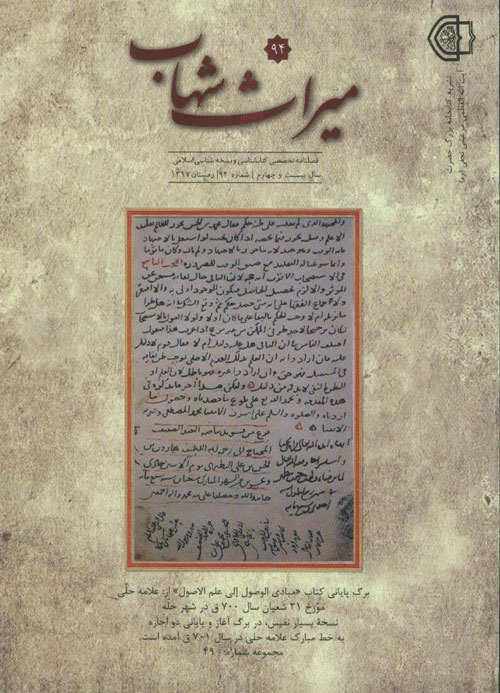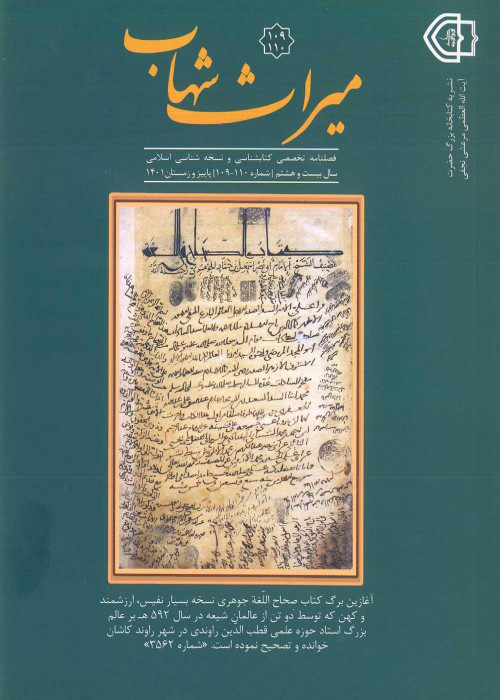فهرست مطالب

نشریه میراث شهاب
پیاپی 94 (زمستان 1397)
- 240 صفحه،
- تاریخ انتشار: 1398/06/10
- تعداد عناوین: 9
- مقالات
-
موقوفات ماندگار / بخشی از نسخه های خطی اهدایی حضرت آیت الله العظمی مرعشی نجفی به حوزه علمیه اردبیلصفحه 3
-
صفحه 25
- معرفی کتاب
- شرح حال نگاری
- نسخه شناسی
-
از مجلس راستگویان / گزارشی از نسخه کهن امالی شیخ صدوقصفحه 183
- تصحیح متون
-
صفحه 231
-
Page 3
The outstanding role of Āyatullāh al-‘Uẓmā Mar‘ashī Najafī in the establishment, expansion, and enrichment of the published resources and manuscripts of other libraries has received slight attention so far. Through a series of articles, the author of this paper tries to familiarize the readers with the manuscripts endowed by Āyatullāh to various libraries. In order to attain this goal, the article at hand presents the titles of some manuscripts endowed by Āyatullāh to the library of Ardabīl Ḥawza. These titles are selected from the list of Ardabīl Ḥawza manuscripts (the first imprint) prepared by Ibrāhīm Mulā’ī (published by Library, Museum and Document Center of Iran Parliament, 2014) and are presented after the introduction of numerous corrections and explications.
Keywords: Endowments, Manuscripts, Endowed manuscripts, Mar‘ashīNajafī, Ardabīl Ḥawza, Library resources, Endowed resources, Publiclibraries, Resource endowment, Manuscripts -
Page 25
The author of the article at hand has explored several issues. First, he gives in a detailed discussion about Sayf b. ‘Umar Tamīmī Asīdī, the newly found manuscript of the book Al-Ridda wa al-Futuḥ, Sayf’s method for the development of the historical reports, and the formation of his historiography. The author of this paper extensively discusses Sayf’s historical reports on the prominent events and the manner of his manipulation of those reports, and shows that how Sayf has deliberately distorted the historical reports. Then, he talks about the Old Bahraini emigrant Shī‘a clans and scholars in Iran such as ‘Abd al-Jabbār clan or Āl ‘Abd al-Muḥsin and their scientific contributions or practical actions for the facilitation of conditions for Iranian Hajj pilgrims. The pilgrimage to Mashhad in the Imāmīte scholars’ view and their attention to manuscripts due to their role in provision of a clearer picture of the scientific conditions in Jabal ‘Āmil in the 9th century AH along with the presentation of some points about an unknown scholar from Jabal ‘Āmil in the 9th century AH are other discussions provided in the article. Finally, the author concludes the article by an extensive examination of the Arabization of Persian words and their use in the correction of ancient texts along with the presentation of some points about Shaikh ‘Abd al-Muḥsin Lu’aymī and his clan.
Keywords: Sayf b. ‘Umar Tamīmī Asīdī, Al-Ridda wa al-Futuḥ, Historicalreports, Historiography, Report distortion, Shī‘a scholars, Emigrant scholars, Old Bahrain, Āl ‘Abd al-Jabbār, Āl ‘Abd al-Muḥsin, Mashhad pilgrimage, Jabal ‘Āmil, Arabization, ‘Abd al-Muḥsin Lu’aymī, Abū Ḥatam Rāzī -
Page 113
written in Persian by Rashīd al-Dīn Abulfaḍl Meybudī in ten volumes. This book is a rich source of interpretation, esoteric interpretation, Islamic knowledge, poetry, and Arabic and Persian literature. Meybudī started authoring the foregoing book in the early 520 AH, adopting Al-Hirawī’s commentary Khājah ‘Abdullāh Anṣārī as his role model. The author of this paper presents some Persian equivalents of the qur’ānic terms, while borrowing examples from other qur’ānic dictionaries, too.
Keywords: Kashf al-Asrār wa ‘Uddat al-Abrār, Rashīd al-Dīn AbulfaḍlMeybudī, Interpretation of the Qur’ān, Mystic interpretation, PersianCommentaries, Qur’ānic Dictionary -
Page 125
The book Muntaqid al-Manāfī‘ fī Sharḥ al-Mukhtaṣar al-Nāfi‘ is one of the scientific works of Mullā Ḥabībullāh Kāshānī in the domain of demonstrative jurisprudence, and is in fact a comprehensive interpretation of Muḥaqqiq Ḥillī‘s al-Mukhtaṣar al-Nāfi‘. In this book, Mullā Ḥabībullāh has only explicated the important jurisprudential issues that – according to him – face the Muslim seminarians through a simple language and a scholarly method. After stating the problem, quoting the words of Muḥaqqiq Ḥillī (may God have mercy on him), and presenting narrations from the Infallibles (a) and opinions from Muslim jurists, he extensively discusses his own grand ideas under the titles Tadhnīb (follow-up) or Tadhnībāt (follow-ups). The author of this article, first, presents a brief biography of the author of this book and his motivation for the composition of it. Then, he reviews the main topics of the book Muntaqid al-Manāfī‘ along with its qualities, content, and manuscript.
Keywords: Muntaqid al-Manāfī‘ fī Sharḥ al-Mukhtaṣar al-Nāfi‘, Al-Mukhtaṣaral-Nāfi‘, Islamic laws, Muḥaqqiq Ḥillī, Demonstrative jurisprudence, MullāḤabībullāh Kāshānī, Commentary of the book al-Mukhtaṣar al-Nāfi‘, Jurisprudential issues, Tadhnīb, Tadhnībāt, Book introduction -
Page 133
Muḥammad ‘Alī Sonqorī ῌāirī (1293 – 1378 AH) the Shī‘a interpreter, Hadith transmitter, theologian, and jurist, the son of Shaikh Muḥammad ῌasan, was born in Karbalā. He became known as Sonqorī due to his migration to the city of Sonqor and years of preaching and guiding the people of that city. During the Constitution movement, Sonqorī went to Sonqor with the recommendation of his teacher, Ākhūnd Khurāsānī and there he promoted the rulings of Islam and solved people’s religious problems. After some years of preaching and promoting Islam, he returned to his birthplace, the Exalted Karbalā, and was taught by Āyatullāh Shaikh Muḥammad Taqī Shīrāzī. However, in 1345 ah, in a letter which was signed by 21 prominent figures of Sonqor like Āyatullāh ῌabībullāh Pīshwāī, the people of Sonqor asked Āyatullāh Muḥammad ῌussein Nāīnī to return him back to Sonqor. So Sonqorī returned to Sonqor because of the repeated requests of people. First, the author of the article at hand briefly introduces the character and probes the life of Muḥammad ‘Alī Sonqorī and in doing so, he points out his works and dissertations, his character through the words of the prominent figures and scientists, and his teachers and licenses. Afterward, he reviews the letter of the people of Sonqor for returning Sonqorī back to the city; after presenting some explanations about the text of the letter, seals, commentaries and archives, he provides the text of the letter and its original manuscript.
Keywords: Muḥammad ‘Alī Sonqorī ῌāirī, Sonqor, Biography, Kermānshāh, Personology, Letter of the people of Sonqor, Reviewing the letter -
Page 145
In the article at hand, the author attempts to provide briefly a list of 41 figures of Luristān’s scholars who had a written relationship with Āyatullāh Mar‘ashī Najafī or was told something by Āyatullāh Mar‘ashī. This article is derived from the other books of the author about the scholars of Luristān, particularly the unpublished book “the Scholars of Luristān and Āyatullāh Mar‘ashī Najafī”. In doing so, against each one of the names, he mentions the type of the relationship such as letter, written piece or any other type of the document and afterward, beneath the name of the person he introduces the document and at the end, he provides a short biography of that scholar.
Keywords: Luristān, Scholars of Luristān, Āyatullāh Mar‘ashī Najafī -
Page 183
Shaikh Ṣadūq’s Ama‘lī is a collection of his Ḥadīth dictation sessions held from Rajab 18, 367 AH to Sha‘bān 19, 368 AH, with the date of each session mentioned at its beginning. What is noteworthy about this book is the variety of its content, which includes different topics of Islamic doctrine, history, rules, ethics, and Ahl al-Bayt’s virtues and glorious deeds. In the article at hand, the author first has a glance at the life of Shaikh Ṣadūq, where he provides information on Shaikh’s birthday, travels, teachers and scholars he narrated from in Ama‘lī, his own students and narrators, his demise, and his works. Then, in order to introduce Shaikh Ṣadūq’s Ama‘lī, the author of this article gives in a brief chronological account of Shaikh’s Ḥadīth dictation sessionsalong with the mentioning of the place each session has been held and the number of the Ḥadīths of each session. Next, through a brief look at the known manuscripts of Ama‘lī and the manuscripts available at Āyatullāh Mar‘ashī Najafī‘s library, he provides a report of a manuscript of Ama‘lī written by Ibn Sukūn Ḥillī. Before introducing this manuscript, he provides the biography of Ibn Sukūn, his teachers, travels, poems, ethical virtues, and date of demise.
Keywords: Dictation, Ama‘lī, Sessions, Shaikh Ṣadūq, Ibn Sukūn Ḥillī, Thebook Ama‘lī, Book introduction -
Page 217
Shī‘a jurists have always had a formative role in the cultural arena and relations of Iran. Hence, reviewing their activities shortly and assessing their works seem inevitable here. In the article at hand, the writer scrutinizes some activities of Muḥammad Ṣāliḥ Allāmah ῌāirī Māzandarānī. In doing so, after a brief introduction of Allāmah as a groundbreaking jurist, he presents one of his edited works entitled “the History of Aristotle”. In addition to some points about Aristotle and Plato, the mentioned work contains some points about the ancient history of Iran. Finally, the writer finishes the article with presenting a list of the works of Allāmah ῌāirī.
Keywords: the History of Aristotle, Aristotle, Plato, History of Iran, Ancient Iran, Allāmah ῌāirī Māzandarānī, Work introduction, Shī‘a jurists, Jurists, Second Pahlawī era


